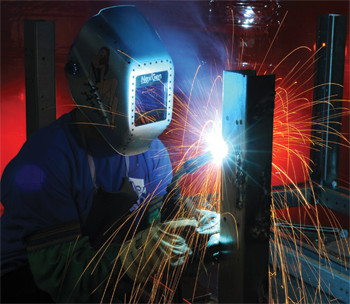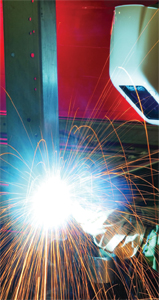ADF vs. Passive Lens Technology
The main cause of eye injury during welding is failing to wear the appropriate PPE, so it’s important to select welding helmets that employees will want to wear. This goal likely will lead metalformers to invest in helmets with ADFs rather than passive filters. According to AWS, there are several disadvantages of fixed-shade passive welding helmets.
• Fixed-shade filters only provide reliable protection if they are worn in the down position. Unfortunately, whenever there is no arc the welder must raise his helmet to see, to start a new weld or to inspect a completed weld. This increases the possibility of injury and can cause a welder to keep his helmet up until the arc is started, further increasing the chances of arc-flash injury.
• There is an increased potential for neck injury or muscle strain from continually nodding the helmet up or down.
• It’s harder to see the precise location of the arc start, causing out-of-position starts that can inhibit productivity.
AWS also points out some advantages of ADFs.
• ADFs allow continuous visibility of the workpiece and arc zone before, during and after striking an arc, and without raising the helmet. This allows welders a better opportunity to achieve a perfect weld the first time, for improved productivity.
• The need for nodding the helmet up or down is eliminated, reducing strain and possible neck injury and reducing the chance for eye injury from flying particles or arc rays.
• Weld starts are likely to be more accurate.
Payback Comes QuicklyProviding welders with the appropriate ADF welding helmet can help avoid medical and worker’s compensation costs associated with acute eye injuries, as well as OSHA fines. But it also can help avoid costs associated with longer-term injuries, specifically “welder’s neck,” which may result from poor posture while welding or by continual nodding as required with fixed-shade helmets.
Welding helmets can weigh as much as 3 lb., and that additional load is placed on the neck and cervical spine. Whether the welding helmet is in the up or down position, it adds weight and forward stress on the spine. In fact, a welder may generate more than 50 lb. of internal force in his neck and back. The further outside the spine’s base of support the external force is held, and the heavier the welding helmet, the greater strain on the neck muscles and intervertebral discs. If this force is held in this position for long periods of time, the intervertebral disc can tear and lead to herniation. To help prevent neck fatigue, strain and degenerative disc disease, lighter-weight helmets and those that don’t need to be nodded down are recommended.
ADF welding helmets also can help improve productivity. First, the time required for an ADF helmet to switch from light to dark is much less than the time it takes to manually lower a passive helmet, whether by hand or nodding. While the few seconds saved may seem inconsequential, they can add up to increased welding output when one considers the total time saved by an entire crew over a shift. In fact, research shows that a single welder can save an average of 4 min./hr. using an ADF helmet rather than a passive helmet. Based on an average labor rate of $16.5/hr., that productivity gain allows a metalformer to save about $1.10 for every hour welders wear an ADF helmet. Extrapolate those figures and it’s possible to recover the investment in an ADF helmet in just a few weeks.
Second, elimination of helmet nodding reduces the chances that a welder will jar the electrode from its starting position, helping to ensure more accurate welds that will require less rework.
Third, the ability of ADF helmets to afford a clear, unobstructed view of the weld in light and dark states further improves weld quality and welder productivity. And fourth (the cost benefits are starting to add up), ADF helmets may allow the welder to more easily work in confined spaces, where there simply isn’t room to enter with the helmet in the up position.
Comfortable = ProductiveCommon sense tells us that a comfortable welder is a more productive welder. And while the purchase price of an ADF helmet compared with that of a passive-filter helmet may give some metalformers pause, the productivity advantages inherent with ADF helmets more than make up for the premium cost.
Further, some helmet suppliers also make it easier for welders to cost-effectively upgrade the performance of their welding helmet by offering component systems. Users can mix and match standard headgear to different shells and lens options, and swap them out to optimize performance based on the application, without having to buy completely new helmets. MF
See also: Kimberly-Clark Corporation
Technologies: Safety, Welding and Joining
Comments
Must be logged in to post a comment. Sign in or Create an Account
There are no comments posted.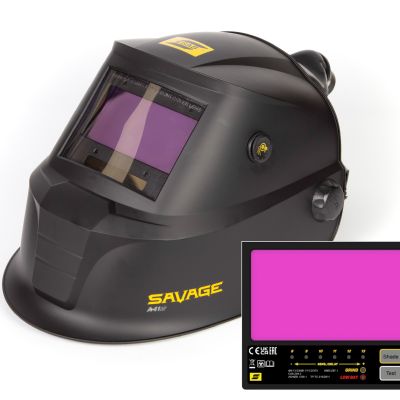 Welding and Joining
Welding and JoiningEnhanced Welding Helmet Features Digital Interface, Extended...
February 12, 2025
Miller Electric Introduces Clearlight 4X Welding Helmet at F...
November 8, 2024
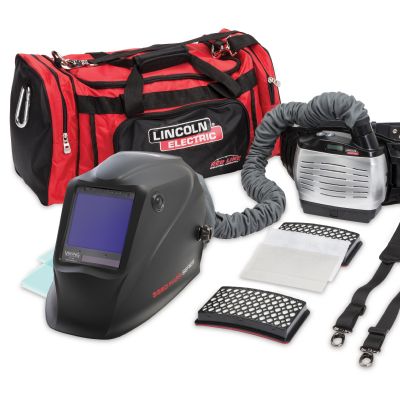 Welding and Joining
Welding and JoiningHelmet and Respirator for Welding and Grinding
Friday, July 24, 2020
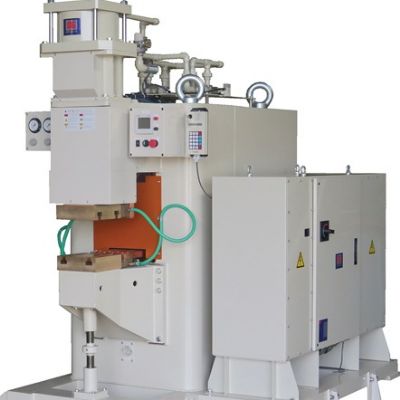 Welding and Joining
Welding and Joining50kA Capacitor Discharge Welder
Wednesday, September 18, 2019







